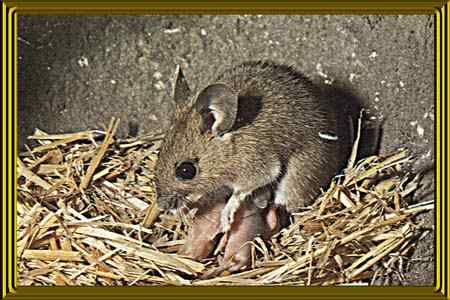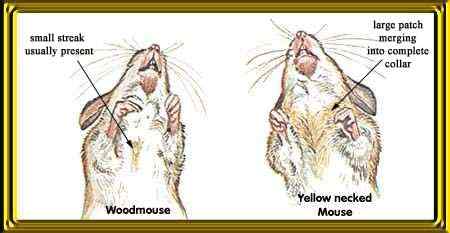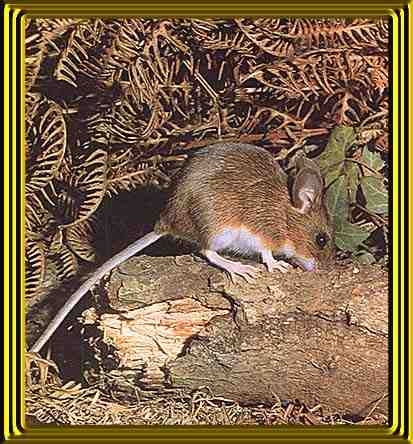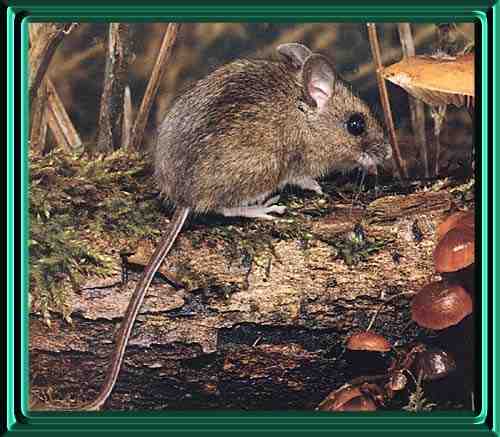
Apodemus
sylvaticus
(The Wood mouse)
(Field mouse)
(Long tailed Field mouse)
The wood mouse can easily be distinguished from the house mouse by its larger ears and eyes. Its warm brown coat cannot generally be confused with the dull greyish coat of the house mouse, although unusual colour variations and the grey fur of the young of both species may make identification more difficult. The wood mouse does not have the distinctive odour associated with the house mouse.Wood mice have soft, smooth fur which is sandy or orange brown on the head and back, yellowish on the flanks and white on the belly. There is usually a small streak of yellow pigmentation in the otherwise white fur of the chest. The tail is almost as long as the body and has a sparse covering of black hairs. The tops of the feet are covered by short white hairs and each toe - four on the fore feet and five on the hind - ends in a sharp claw.
Some biology:
Size: This varies according to season and locality. On mainland Britain in the spring: Male is 25g and the female is 20g (unless she is in an advanced stage of pregnancy).
Colour: Sandy or orange brown on head and back, yellow on flanks, white on belly. Young: greyish brown.
Breeding season: March/April to October/November.
Gestation: 25 - 26 days.
No of young: Usually 2 - 9 with an average of 5.
Lifespan: This averages 2 - 3 months, may survive 18 - 20 months in the wild, 2 years or more in captivity.
Food: Mostly seeds, but eats a wide range of plant and animal food.
Predators: Cat, weasel, tawny owl, long - eared owl.
Distribution: Widespread in Britain and Ireland and also on many of the surrounding islands.
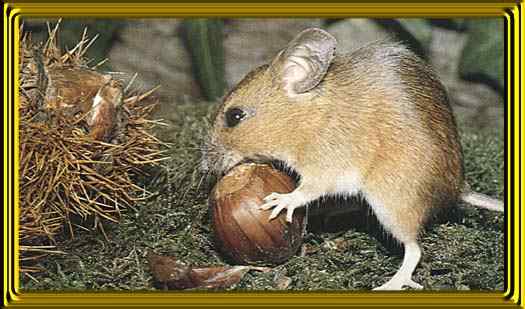
Wood mice are primarily seed eaters (granivores), relying to a great extent on the seeds of trees such as oak, beech, ash, lime, hawthorn and sycamore. Every year they eat a high proportion of the annual seed crop and it seems likely that only small quantities of seed therefore, survive to germinate the following spring. The mice are efficient seed gatherers and when there is a plentiful supply on the ground, they carry them back to the nest for storage. Small invertebrates, particularly small snails and insects, may be eaten throughout the year, but are particularly important sources of food in late spring and early summer. This is the time of year when seeds are least available and larval and adult insects are abundant. Moth caterpillars which fall from the upper canopy of trees to pupate in the soil, are a common food in summer.
Below young wood mice are born naked and blind. They grow their first greyish-brown coat after about six days, their eyes open after 16 days and they are weaned at around 18 days old. Survival of the young and adults is poor during the first half of the breeding season. Adult males are aggressive to one another and to the young, who are driven from the nest soon after weaning. Adult females may be weakened by constant pregnancies and feeding of the young.
The yellow necked mouse (Apodemus flavicollis) is similar in appearance to the wood mouse, but it is larger, weighing up to 45g, and has a distinctive collar of yellow fur (see picture below).
The two species behave differently when handled. While the wood mouse is relatively passive, the yellow necked mouse struggles and squeals. The yellow-neck is restricted to the south-east, south and west of England and to the eastern parts of Wales, where it is found mainly in mature deciduous woodland areas. Although it is not aggressive towards the wood mouse, it is avoided by this smaller, less dominant animal and, within a shared area of woodland, the two species may rarely meet. Little is known about the diet of the yellow-neck, but it is probably similar to that of the wood mouse.
The annual population cycle differs slightly to that of the wood mouse. Numbers increase from the start of the breeding season in spring. At this time, the mice may move into a variety of habitats from the restricted woodland areas in which they have spent the winter. The population continues to increase throughout the autumn, but survival in the winter is poor and by early spring the yellow-neck is scarce throughout it's range of habitats.
As you can see from the picture below the yellow-neck is almost identical to the wood mouse.
